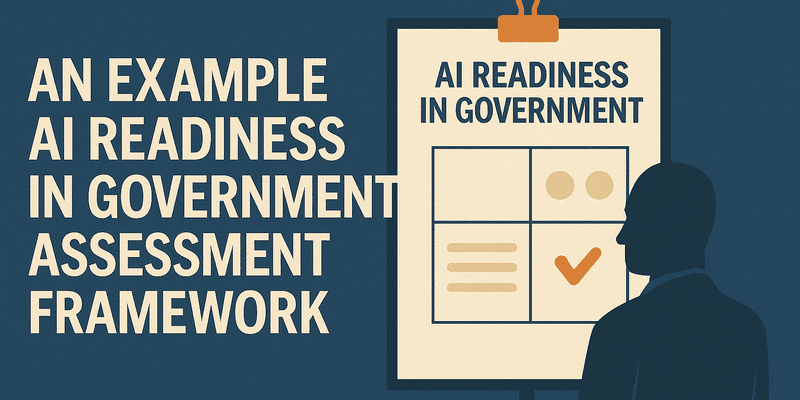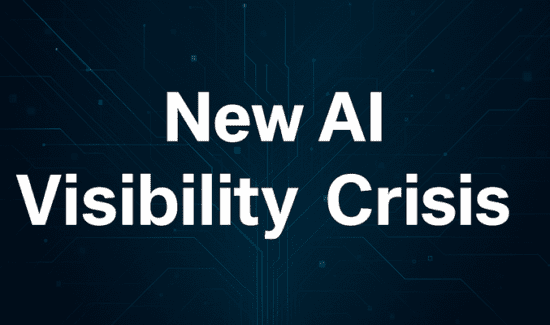An Example AI Readiness in Government Assessment Framework

Tim King offers an example AI readiness in government assessment framework, part of Solutions Review’s coverage on the human impact of AI.
Artificial intelligence is reshaping how governments serve, protect, and interact with the public. From traffic optimization and fraud detection to unemployment claim automation and predictive healthcare modeling, AI offers profound opportunities for efficiency and innovation in the public sector. But with great power comes greater scrutiny—and even greater responsibility.
Unlike private enterprises, government institutions aren’t just answerable to shareholders. They’re accountable to every citizen, every community, and every constitutional principle. That makes AI readiness in government uniquely complex. It must be grounded not only in technology and governance, but in law, equity, transparency, and public trust. Where businesses might optimize for speed or scale, public agencies must optimize for fairness, accessibility, and long-term societal impact.
Why Public Sector AI Demands More
Yet many agencies are racing to deploy AI before they’re fully prepared—before they’ve addressed critical questions like: Are our datasets inclusive and unbiased? Do we have oversight structures in place to monitor impact? How do we ensure automated decisions are explainable and contestable by the public? And who bears responsibility when things go wrong?
This guide is designed to be the definitive readiness roadmap for public institutions. It outlines the core pillars of AI readiness in government and introduces custom tool-based strategies for assessing and improving your preparedness. From interagency data governance to procurement reform, algorithmic transparency, and civic engagement—this is about building AI not just for the public, but with the public in mind.
In the age of automation, readiness isn’t just a matter of technical capability. It’s a matter of democratic integrity.
Important: AI Won’t Replace You, But Lack of Soft Skills Might – Get Report
AI Readiness in Government Assessment Framework
AI Readiness in Government: Mission Alignment & Public Trust
At the heart of government is public service—not profit, not market share, but mission-driven impact. That’s why the first pillar of AI readiness in government must be clear mission alignment. Before any algorithm is built or procured, public agencies must ask: How does this support our mandate to serve the people? And just as importantly: Does it do so in a way that earns and preserves public trust?
In the private sector, AI is often driven by performance metrics. In government, it must be driven by purpose. This means AI systems should not only deliver efficiency, but enhance the agency’s core duty to equity, transparency, due process, and human dignity. It also means recognizing that public perception matters. Even a technically sound system can erode trust if it’s implemented without consultation, poorly communicated, or seen as undermining human accountability.
To align with mission and build trust, governments must:
-
Define clear, citizen-centered goals for each AI initiative.
-
Ensure AI use cases reflect—not replace—existing democratic values.
-
Anticipate where automated decisions could harm vulnerable communities.
-
Communicate proactively and accessibly about what the technology does and doesn’t do.
-
Be prepared to explain how public input was gathered and incorporated.
Public trust is fragile, especially in marginalized communities with a history of surveillance or exclusion. That’s why readiness here isn’t just about capability—it’s about credibility. When citizens see that AI is being used with them in mind, not on them or against them, confidence grows. And when government leaders root AI initiatives in their agency’s highest mission—not just modernization or cost savings—they earn the right to innovate with integrity.
AI Readiness in Government: Data Sovereignty, Integrity & Interagency Collaboration
Data is the lifeblood of artificial intelligence—but in government, that lifeblood must flow with care, coordination, and constitutional caution. Public sector data often spans multiple departments, jurisdictions, and generations of legacy systems. It may contain sensitive information about citizens, from tax records and social services to criminal justice and immigration status. That makes data sovereignty, integrity, and interagency collaboration foundational pillars of AI readiness in government.
First, sovereignty: Governments must ensure that the data used to train and inform AI systems remains under appropriate public control. This includes safeguarding data from unauthorized third-party use, avoiding overreliance on black-box vendor models trained on opaque or private data, and ensuring compliance with data residency, consent, and retention laws. Public data should not be treated as a commodity—it is a civic asset, and it must be governed accordingly.
Next, integrity: Government AI models must be trained and tested on data that is accurate, current, complete, and representative. But outdated systems, fragmented record-keeping, and inconsistent data standards often pose major barriers. AI readiness demands an honest assessment of data quality, lineage, and bias—especially when datasets reflect systemic inequalities that could be perpetuated or magnified by automation.
Finally, collaboration: No government agency operates in isolation. AI initiatives often require data sharing across departments, municipalities, or even federal and state lines. But without common frameworks, interoperability suffers—and so do outcomes. Agencies must work together to standardize data governance, align security protocols, and ensure cross-jurisdictional use respects the same ethical and legal boundaries.
AI Readiness in Government: Legal & Constitutional Constraints
In the private sector, AI governance is often guided by emerging best practices and voluntary standards. In government, however, AI must answer to a higher authority: the law. From constitutional protections to statutory obligations and administrative codes, legal and constitutional constraints define the hard perimeter around what public agencies can—and cannot—do with artificial intelligence.
That means AI readiness in government starts with legal literacy. Agencies must understand how existing laws apply to algorithmic systems, even if those laws were written long before AI existed. For example, any system that makes or influences decisions about employment, benefits, criminal justice, education, or voting must comply with due process, anti-discrimination statutes, equal protection clauses, and records transparency laws.
Critically, public agencies must ensure that AI never becomes a substitute for procedural fairness. Citizens must retain the right to understand, challenge, and appeal decisions—whether those decisions are made by a human caseworker or an automated scoring algorithm. Failing to provide adequate notice, explanation, or redress can turn a technological misstep into a constitutional violation.
There’s also the question of surveillance. AI-driven tools such as facial recognition, predictive policing, and social media monitoring have already triggered public backlash and legal challenges. The Fourth Amendment and state-level privacy laws impose strict boundaries on how data can be collected and used. Government AI that overreaches—even unintentionally—can quickly cross into unlawful territory.
AI readiness here requires more than compliance—it requires anticipation. Agencies must proactively identify legal risks, involve counsel early in the design process, and document every step from data collection to model deployment. Empathetic AI governance ensures that legality isn’t an afterthought—it’s a design constraint that protects both institutions and the public they serve.
AI Readiness in Government: Procurement Policy & Vendor Vetting in the Public Sector
Government agencies rarely build AI solutions entirely in-house. Most rely on third-party vendors—startups, cloud providers, system integrators—to develop, deploy, or maintain AI-powered tools. But traditional public procurement processes were not designed for fast-moving, opaque, and high-risk technologies like artificial intelligence. That makes procurement reform and vendor vetting a critical pillar of AI readiness in government.
At present, many public sector AI deployments are driven more by vendor capability than public values. Contracts often lack transparency requirements, audit rights, or clear standards for explainability, fairness testing, or human oversight. This creates serious downstream risks: systems that can’t be interrogated, outcomes that can’t be explained, and failures that can’t be traced or remediated—especially when the original vendor is no longer under contract.
True readiness demands that governments shift from being passive buyers of “AI as a service” to strategic stewards of public interest technology. That means embedding ethical, legal, and operational requirements into every step of the procurement lifecycle—from RFPs to pilot evaluations to contract renewals. It also means evaluating vendors not just on price and speed, but on transparency, governance features, data rights, and long-term accountability.
Key considerations include:
-
Does the vendor disclose the training data sources, risk mitigation strategies, and model limitations?
-
Is there contractual language for independent audits, human-in-the-loop safeguards, and deployment rollback procedures?
-
Can the vendor meet requirements for open data standards, explainability, and redress in accordance with public records laws?
-
Will the vendor provide source code access, documentation, or meaningful updates post-deployment?
Empathetic AI procurement recognizes that when a government agency buys AI, it’s not just buying code—it’s shaping how public power is exercised. It treats vendor selection as a civic decision with long-term societal consequences, and ensures no model enters public service without scrutiny equal to its impact.
AI Readiness in Government: Workforce Capability in Government Agencies
AI readiness in government isn’t just about systems—it’s about people. No model can be safely or effectively deployed if the public workforce lacks the understanding, confidence, or capacity to manage it. That’s why workforce capability is one of the most urgent pillars of government AI readiness. Without it, even the most promising tools will flounder—or worse, create harm no one knows how to detect, interpret, or stop.
Most government agencies today are staffed by policy analysts, caseworkers, administrators, legal experts, and technical generalists—not AI engineers. And while that’s appropriate—governments exist to serve people, not build tech from scratch—it means that successful AI implementation depends on upskilling, cross-training, and deeply embedding AI literacy across roles. Everyone from the procurement officer to the program director to the front-line service provider must have at least a working understanding of what AI is doing and why.
AI readiness here involves three distinct capabilities:
-
Strategic Literacy: Leaders must be able to evaluate AI proposals through the lens of mission alignment, risk, and governance—not just innovation hype.
-
Operational Proficiency: Program and IT staff must be equipped to manage, monitor, and maintain AI systems day to day, including spotting issues with bias, drift, or degradation.
-
Civic Confidence: Frontline employees must be confident in explaining AI-driven decisions to citizens, navigating edge cases, and escalating concerns when something doesn’t look right.
Empathetic government doesn’t treat workforce training as an afterthought. It recognizes that AI literacy is civic infrastructure—and invests accordingly. This includes agency-wide training programs, shared competency frameworks, role-based skill mapping, and partnerships with universities or public tech initiatives to build talent pipelines. When government employees feel empowered—not intimidated—by AI, systems run smoother, accountability increases, and trust follows.
AI Readiness in Government: Equity, Accessibility & Algorithmic Fairness Mandates
Governments are held to the highest standards of fairness—rightfully so. Every policy, every decision, and now every AI deployment must serve the public without bias, discrimination, or exclusion. That’s why equity, accessibility, and algorithmic fairness aren’t optional features in a government AI readiness framework—they are foundational mandates.
AI systems can replicate, amplify, or even create inequalities—especially when trained on historical data that reflects systemic biases. In the public sector, this can have life-altering consequences: an algorithm might unfairly flag certain communities for fraud investigations, miscalculate benefit eligibility, or recommend policing patterns that deepen over-surveillance in already marginalized neighborhoods. Inaccessible interfaces can exclude those with disabilities or limited digital literacy. And language models not tuned for multilingual populations can shut people out of essential services.
AI readiness here requires governments to bake equity into every phase of development and deployment:
-
Conduct pre-deployment fairness audits using demographic breakdowns.
-
Establish accessibility standards for AI-driven digital services, ensuring they are usable by those with disabilities or limited internet access.
-
Design processes for public input—particularly from underserved communities—during model design, testing, and refinement.
-
Maintain appeal and redress mechanisms for decisions perceived as unfair or discriminatory.
More importantly, equity is not a one-time box to check. It requires ongoing monitoring, community consultation, and willingness to adjust or sunset systems that fall short. That’s what distinguishes ethical governance from technocratic overreach.
Empathetic AI in government doesn’t treat fairness as a legal risk—it treats it as a democratic responsibility. When agencies proactively safeguard equity and accessibility, they not only build better tools—they build deeper public trust.
AI Readiness in Government: Public Participation & Community Input
In a democratic society, decisions that affect the public should involve the public—and that includes decisions made or influenced by AI. Too often, artificial intelligence is implemented behind closed doors, with little to no opportunity for citizen awareness, let alone consent or contribution. For governments, this lack of transparency isn’t just risky—it’s fundamentally out of step with democratic values. That’s why public participation and community input are critical pillars of AI readiness in government.
AI systems shape eligibility for benefits, determine funding priorities, and automate decisions with real-world impact. The people affected by these systems—especially historically underserved or over-surveilled communities—must have a voice in how AI is designed, deployed, and governed. Without inclusive input, agencies risk not only technical failure, but social backlash, legal challenges, and a deep erosion of public trust.
Empathetic governments proactively create mechanisms for meaningful public engagement at every stage of the AI lifecycle:
-
Hosting community forums and listening sessions before deploying new AI systems.
-
Inviting public comment on proposed use cases or vendor partnerships.
-
Including representatives from impacted communities in ethics review boards or advisory panels.
-
Offering educational resources to help citizens understand and question automated decision-making processes.
Public engagement also improves system design. Community members often raise concerns or use cases that technologists and policymakers miss—such as language barriers, accessibility gaps, or historical misuse of data. When agencies listen early and often, they not only strengthen their AI governance—they build shared ownership and legitimacy.
True AI readiness means more than regulatory compliance. It means aligning with the civic spirit of public service: co-creating the future with the people, not just for them.
AI Readiness in Government: Transparency & Explainability as a Public Right
In the private sector, AI transparency is a competitive advantage. In government, it’s a constitutional obligation. Public institutions are duty-bound to explain their actions, justify their decisions, and remain accountable to the people they serve. As AI systems begin to shape eligibility, access, and enforcement across vital services, transparency and explainability are no longer optional—they are a matter of public right.
Government agencies must be prepared to clearly explain how AI systems work, what data they rely on, how they make decisions, and what recourse is available when outcomes are contested. This is especially important in high-stakes contexts such as healthcare, education, policing, and public benefits—where the line between support and harm can be razor-thin.
Explainability is not just a technical feature. It’s a social and civic imperative. Citizens have a right to know:
-
When an AI system is influencing decisions that affect them.
-
What logic or criteria the system uses.
-
How they can appeal or request a human review.
-
Who is ultimately accountable.
Government readiness means building transparency by default into AI governance. This includes:
-
Publishing AI usage logs, model documentation, and decision policies.
-
Making plain-language summaries available alongside technical artifacts.
-
Disclosing third-party vendors and data sources.
-
Training staff to communicate system behavior clearly and empathetically to the public.
An AI system that can’t be explained is, by definition, ungovernable. In the public sector, that’s not just a technical failing—it’s a breakdown of democratic accountability. Empathetic government AI is not just powerful. It’s legible. Understandable. Answerable.
AI Readiness in Government: Ethical Governance & AI Oversight Bodies in Government
When artificial intelligence is deployed in the public sector, it isn’t just automating decisions—it’s extending the power of the state. That’s why ethical governance and oversight are indispensable to AI readiness in government. Unlike private companies, which may self-regulate, governments are stewards of democratic power and must be held to higher standards through structured, independent, and transparent review processes.
This is where formal AI ethics review boards and governance councils come in. These bodies ensure that any AI system being considered for procurement, pilot, or deployment is evaluated not only for performance, but for fairness, legality, necessity, and human impact. They act as guardrails between technical ambition and democratic obligation—ensuring that civil liberties, social equity, and constitutional rights are not sacrificed in the name of efficiency.
A mature government AI oversight structure includes:
-
Pre-deployment review of all high-impact or citizen-facing AI systems.
-
Multidisciplinary participation—bringing together ethicists, legal experts, technologists, and community advocates.
-
Regular audits of deployed systems for drift, bias, and unintended harm.
-
Public documentation of board decisions and ethical assessments.
-
Clear escalation protocols for when systems fail or face public concern.
These boards should not operate in the shadows. Their credibility hinges on visibility, transparency, and public input. Empathetic AI governance means that citizens know who is watching the algorithms—and who is accountable when things go wrong.
Readiness here is not just about having a framework—it’s about embedding it into the workflow. Every AI procurement, every pilot, every policy must move through ethical review like any other matter of public consequence. That’s how we ensure that AI systems respect the values they’re meant to serve.
AI Readiness in Government: Budgeting for AI with Fiscal Responsibility
AI can create cost savings—but it also comes with real costs. From vendor contracts and infrastructure upgrades to talent acquisition, governance mechanisms, and long-term maintenance, artificial intelligence is not a one-time line item. For public sector organizations, where every dollar is taxpayer money, fiscally responsible budgeting is a critical component of AI readiness.
Too often, government AI projects are funded through narrow innovation grants or short-term modernization budgets that don’t account for lifecycle costs. A flashy pilot might get greenlit, only to be quietly abandoned when post-deployment support, retraining, auditing, or redress mechanisms prove too expensive to sustain. AI readiness requires a shift in mindset: from project-based spending to stewardship-based investment.
That includes budgeting for:
-
Long-term system maintenance and regular performance tuning.
-
Human oversight resources, such as reviewers, auditors, and ethics board staff.
-
Ongoing staff training across technical, operational, and front-line roles.
-
Third-party audits and fairness testing services.
-
Public communication and engagement to support transparency and participation.
Empathetic budgeting also means funding the “invisible infrastructure” that ethical AI depends on—data cleaning, impact reviews, documentation, feedback loops—not just the shiny front-end applications.
Crucially, public AI budgets must also be scrutinizable. Citizens deserve to know not just how much money is being spent on AI, but why, with whom, and toward what outcomes. Transparent line items, procurement disclosures, and ROI frameworks grounded in public value—not just cost-cutting—can ensure AI spending supports mission-aligned, trust-building outcomes.
AI Readiness in Government: Cybersecurity & AI Risk Management
Artificial intelligence doesn’t just introduce new capabilities—it introduces new attack surfaces. From adversarial inputs that confuse models, to data poisoning, model inversion, and prompt injection attacks, AI systems carry a novel and expanding risk profile. In the public sector, where systems often handle sensitive citizen data and support critical infrastructure, cybersecurity and risk management must be foundational to AI readiness.
Many government agencies already operate with strict cybersecurity protocols, but traditional frameworks often lag behind when it comes to AI-specific vulnerabilities. An algorithm trained on a tainted dataset can make decisions that look “correct” on the surface but embed systemic risks. A chatbot connected to public services may unintentionally leak private information. A misaligned model in a crisis-response context can cause more harm than help. These aren’t just theoretical risks—they’re emerging in real-world use cases every day.
AI readiness requires government agencies to:
-
Integrate AI into existing cybersecurity frameworks, not treat it as a separate track.
-
Conduct red teaming and stress testing of models to identify edge-case vulnerabilities.
-
Implement access controls on training data and inference APIs.
-
Use model watermarking and versioning for traceability and accountability.
-
Establish incident response plans specific to AI failure modes—technical, ethical, and reputational.
Just as importantly, governments must anticipate human adversaries. AI systems can be exploited by bad actors—foreign and domestic—seeking to manipulate outcomes, evade detection, or damage institutional credibility. Preparing for these scenarios requires active monitoring, continuous learning, and cross-agency intelligence sharing.
Empathetic AI governance means protecting not just the technology, but the people who rely on it. That’s why security in government AI must be not only defensive, but proactive—framed around public risk, civic resilience, and the evolving nature of digital threats.
AI Readiness in Government: Post-Deployment Monitoring & Democratic Accountability
AI readiness doesn’t end at deployment—it begins a new chapter. In government, where systems serve millions and touch matters of justice, welfare, safety, and liberty, post-deployment monitoring and democratic accountability are not optional—they are the lifeblood of legitimate governance. An AI tool that works well in testing can behave very differently in the wild. Conditions shift, user behaviors evolve, feedback emerges, and unintended consequences surface.
Government agencies must be equipped to continuously monitor AI systems after rollout—not just for technical performance, but for human impact. Are certain communities being harmed disproportionately? Is the model drifting from its intended purpose? Are appeals and complaints increasing over time? Are the results still explainable, fair, and aligned with public expectations?
AI readiness means establishing a living feedback loop, with regular audits, redress channels, and escalation protocols. But it also means communicating those findings clearly to the public. Citizens should not need a FOIA request to understand how a public algorithm is performing—or failing. They deserve regular reporting, meaningful engagement opportunities, and assurances that oversight mechanisms are working as designed.
Effective monitoring includes:
-
Automated alerts for outlier behaviors, errors, or usage spikes.
-
User reporting systems to flag concerns from both internal staff and the public.
-
Periodic impact reviews comparing model behavior against equity, accessibility, and legal benchmarks.
-
Public scorecards or dashboards to maintain transparency and build trust.
Most importantly, democratic accountability means AI systems must be stoppable. When harm emerges or trust is lost, there must be procedures in place to pause, retrain, or retire models without bureaucratic paralysis. AI cannot be a runaway train—it must remain subject to human control, civic values, and constitutional oversight.
Final Thought
Governments have a chance to model what ethical AI looks like at scale. To prove that innovation and accountability are not at odds. To show that technology, when guided by empathy, can enhance—not erode—public service. The stakes are high, but so is the opportunity. If we lead with empathy, we don’t just build better AI—we build a more trusted, inclusive, and resilient future for all.
Note: These insights were informed through web research and generative AI tools. Solutions Review editors use a multi-prompt approach and model overlay to optimize content for relevance and utility.



